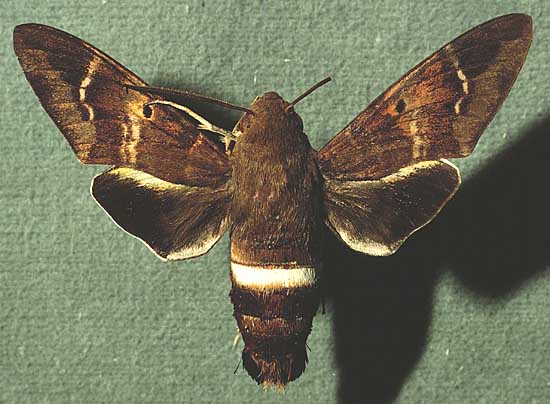
Aellopos titan male courtesy of Dan Janzen.
This site has been created by Bill Oehlke.
Comments, suggestions and/or additional information are welcomed by Bill.
TAXONOMY:
Family: Sphingidae, Latreille, 1802 |
|
|
Updated as per More, Kitching and Cocucci's Hawkmoths of Argentina 2005, October, 2007 Updated as per All Leps Barcode of Life, October, 2007 Updated as per http://biological-diversity.info/sphingidae.htm (Belize), November 2007 Updated as per Fauna Entomologica De Nicarauga, November 2007 Updated as per The Known Sphingidae of Costa Rica, November 2007 Updated as per personal communication with Linda Terrill (Ibera Marsh, Corrientes, Argentina, November 17, 2007) December 2008 Updated as per Sphingidae (Lepidoptera) de Venezuela, Compilado por: Maria Esperanza Chacon; December 2009 Updated as per personal communication with Ezequiel Nunez Bustos (San Ignacio, Misiones, Argentina, November 25, 2009); December 2009 Updated as per personal communication with Gregory Nielsen (Villavicencio, Meta, Colombia, February 24, 2011); March 24, 2011 Updated as per French Guiana Systematics: Sphingidae; May 15, 2011 Updated as per personal communication with Humberto Calero Mejia (Isla Gorgona, Cauca, Colombia, May 31, 2011; 0m); December 17, 2011 Updated as per personal communication with Jeff Trahan (Shreveport, Caddo Parish, Louisiana, October 14, 2009); January 14, 2013 Updated as per personal communication with Bonnie Hay, (Gratiot Lake Conservancy, Mohawk, Keweenaw County, Michigan; June, 29, 2013); July 3, 2013 Updated as per personal communication with Mike Bailey, (Gulf of Mexico, 200 miles south of New Orleans, Louisiana; September 2, 2013; September 13, 2013 Updated as per personal communication with Nigel Venters, (Rio Ceballos, Cordoba, Argentina, November 14, 2013; November 20, 2013 Updated as per "A Hawk Moths fauna of southern Maranhao state, Brazil, ... "; NEVA: Jahrgang 34 Heft 3 November 2013; via Jean Haxaire; April 5, 2014 Updated as per personal communication with Sergio D. Rios Diaz in CATOLOGO DE LOS SPHINGIDAE (INSECTA: LEPIDOPTERA) DEPOSITADOS EN EL MUSEO NACIONAL DE HISTORIA NATURAL DEL PARAGUAY; sent to me in July 2014 by Sergio D. Rios Diaz. Updated as per personal communication with Ezequiel Bustos (Shilap revta. lepid. 43 (172) diciembre, 2015, 615-631 eISSN 2340-4078 ISSN 0300-5267), January 4, 2016 Updated as per personal communication with Biologia beth Franco (Saint Peter, Rio de Janeiro, Brazil, March 22, 2020), March 23, 2020 Updated as per personal communication with Celeste Rouse (Washburn County, Wisconsin, August 12, 2021), August 14, 2021 Updated as per personal communication with Don Severson (Ettirck, Trempealeau County, Wisconsin, August 13, 2021), August 14, 2021 Updated for Brazil as per Haxaire & Mielke, European Entomologist; October 21, 2019; March 29, 2022 Updated as per Hawk-moths (Lepidoptera: Sphingidae) of Trinidad, West Indies: an illustrated and annotated list; Matthew J.W. Cock; April 6, 2022 |

This site has been created by Bill Oehlke.
Comments, suggestions and/or additional information are welcomed by Bill.
TAXONOMY:
Family: Sphingidae, Latreille, 1802 |
DISTRIBUTION:Aellopos titan,
the Titan Sphinx (wingspan: 2 3/16 - 2 9/16 inches (5.4 - 6.5 cm)),
is a strong flying, day sphinx found from
Uruguay and northern
Argentina north through Central America | 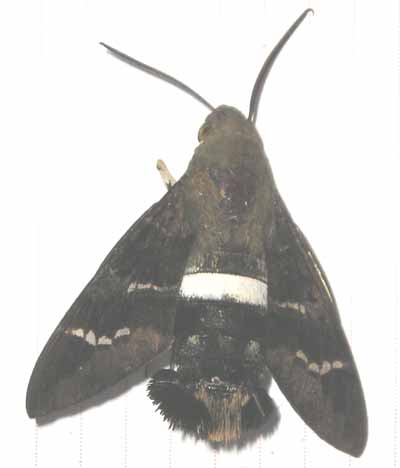 |
Visit Aellopos titan, Ibera Marsh, Corrientes Province, Argentina, November 17, 2007, courtesy of Linda Terrill.
Visit Aellopos titan, San Ignacio, Misiones Province, Argentina, November 25, 2009, courtesy of Ezequiel Nunez Bustos.
Visit Aellopos titan (recto and verso), Isla Gorgona, Cauca, Colombia, May 31, 2011, 0m, courtesy of Humberto Calero Mejia.
Visit Aellopos titan, Gratiot Lake Conservancy, Mohawk, Keweenaw County, Michigan; June, 29, 2013, courtesy of Jim and Bonnie Hay
Visit Aellopos titan, Gulf of Mexico, 200 miles south of New Orleans, Louisiana, September 2, 2013, courtesy of Mike Bailey
Visit Aellopos titan, Rio Ceballos, Cordoba, Argentina, 560m, November 14, 2013, courtesy of Nigel Venters.
Visit Aellopos titan, Sarona, Washburn County and Ettrick, Trempealeau County, Wisconsin, August 12-13. Celeste Rouse and Don Severson.
The sighting in Michigan in late June is quite a surprise, although with all the turbulent weather being experienced in North America, strong winds may have assisted a very early arrival so far north.
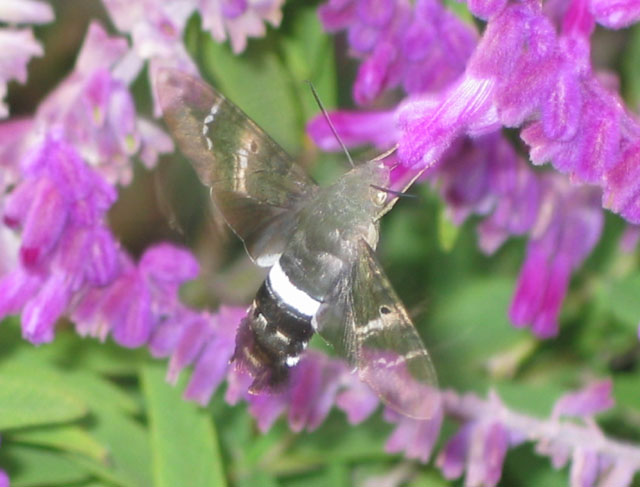
Aellopos titan, nectaring at Mexican Bush Sage, Collin County,
Texas,
5:00pm, October 31, courtesy of Kelly Delany.
The body is dark brown (greenish, dorsally on the thorax, white on undersides of same) with a wide white stripe across the abdomen. The wings are dark brown. The upperside of the forewing has a black spot at the end of the cell and two bands of translucent white spots. The upperside of the hindwing has pale patches along the costa and inner margin.
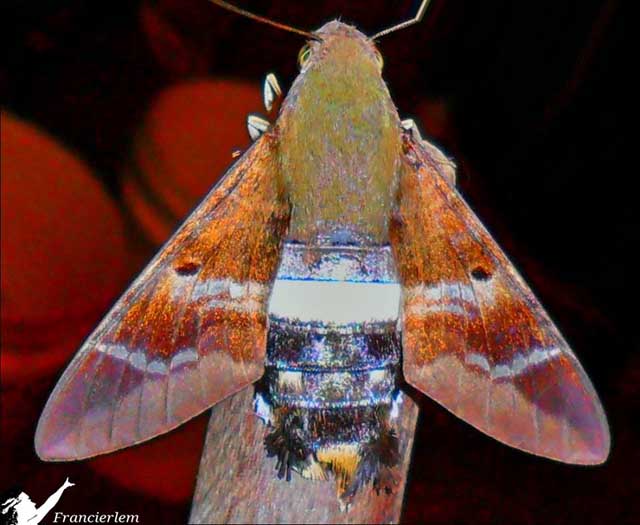
Aellopos titan/tantalus, Extremoz, Rio Grande do Norte, Brazil,
courtesy of Francierlem Oliveira, id by Bill Oehlke.
Jeff Trahan sends the following images of Aellopos titan, Caddo Parish, Louisiana, October 14, 2009. This species probably occurs only as a fall stray, and may have been assisted northwards by hurricane winds.
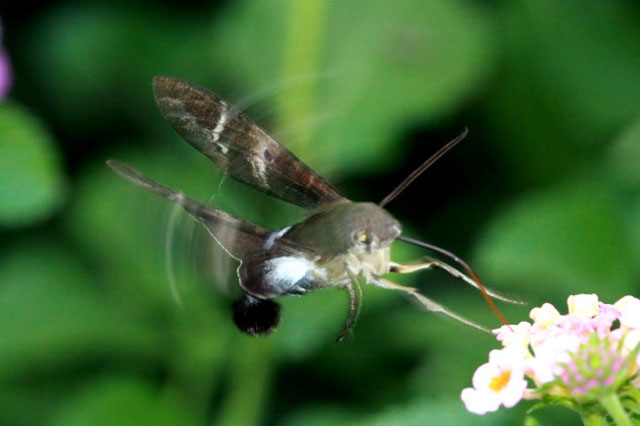
Aellopos titan, Shreveport, Caddo Parish, Louisiana,
October 14, 2009, courtesy of Jeff Trahan.
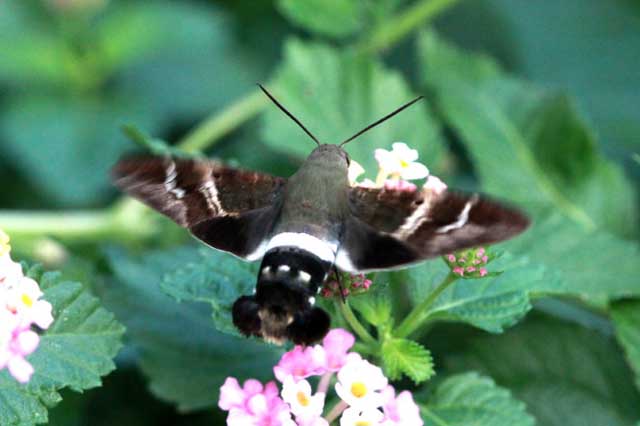
Aellopos titan, Shreveport, Caddo Parish, Louisiana,
October 14, 2009, courtesy of Jeff Trahan.
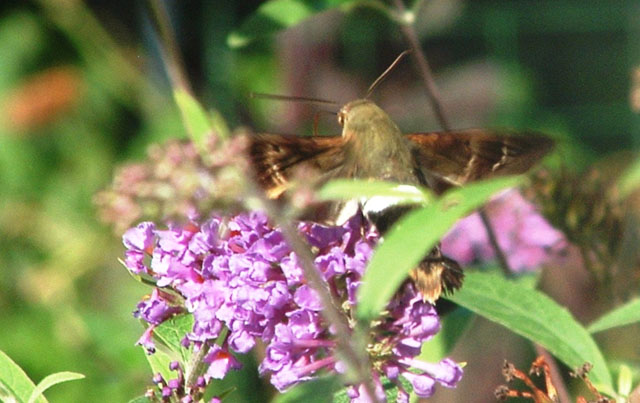
Aellopos titan, Marshalltown, Iowa, September 2005, courtesy of John Jude.
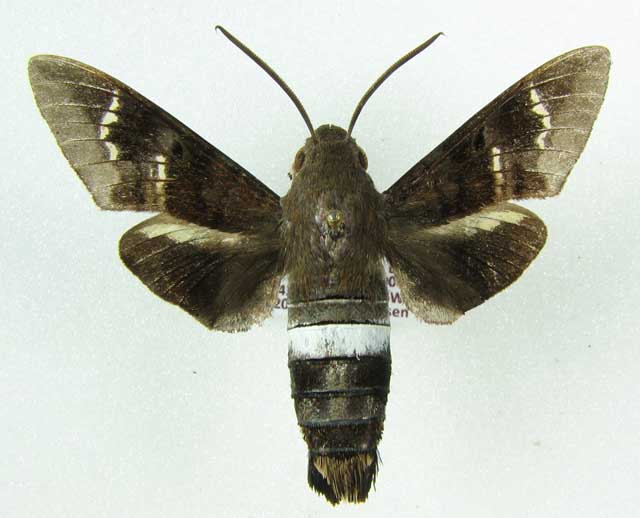
Aellopos titan, Villavicencio, Meta, Colombia,
Km 13 via Acacias, 04�03�55.0 N 073�41�87.0 W
54mm, LFW = 26mm, February 24, 2011, 500m, courtesy of Gregory Nielsen.
FLIGHT TIMES:In Costa Rica moths are taken in all months except February-March and October-November. The moth broods continuously in the tropics. Gregory Nielsen reports a February 24, 2011, flight in Villavicencio, Meta, Colombia. They have been reported in French Guiana in January and April, and probably fly there in other months as well.In more northern locales there is one flight from June-October, but there are multiple broods in Florida. Adults nectar on flowers, including including phlox, lantana, and stoppers. The flower below appears to be a butterfly bush. Paul Santo recorded this one nectaring on milkweed, July 4, 2006, in Washington County, Minnesota. | 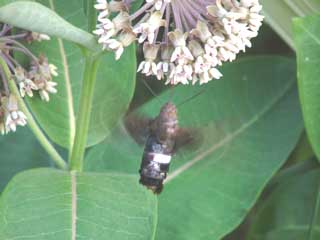 |
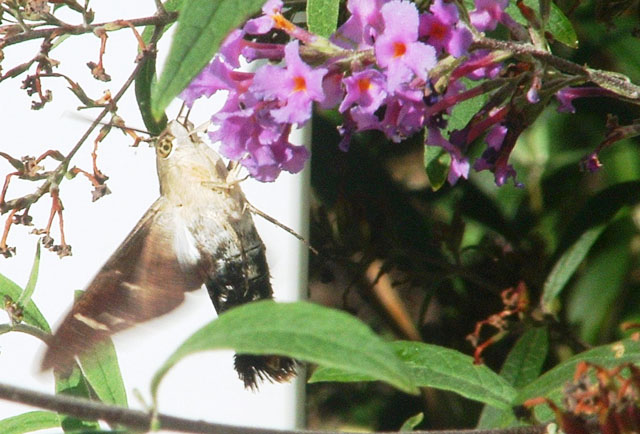
Aellopos titan, Marshalltown, Iowa, September 2005, courtesy of John Jude.
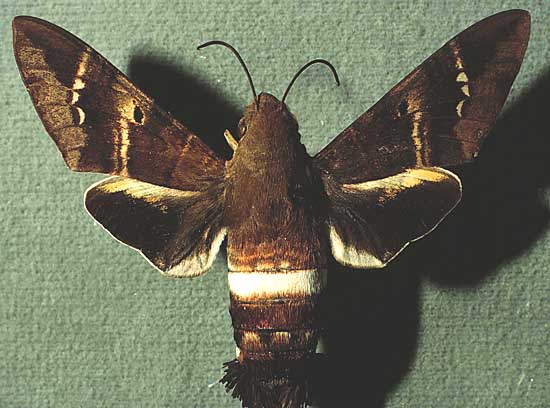
Aellopos titan female courtesy of Dan Janzen.
Yellow-green, translucent eggs are usually deposited singly on foliage or buds.Within a few days, the deleloping larva can be seen through the eggshell. | 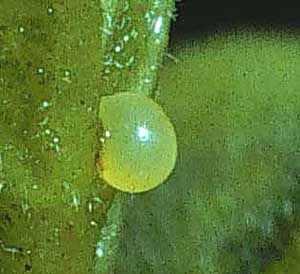 |
There are at least two color morphs, a green form and a much darker, reddish-brown form:

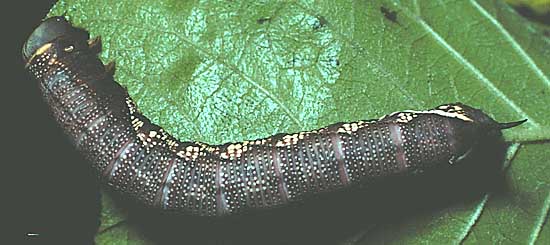
Caterpillars pupate in loose cocoons in shallow underground chambers.Pupae are dark, smooth and shiny, and relatively thin considering the stout appearance of the moth. This one shows parasite damage. | 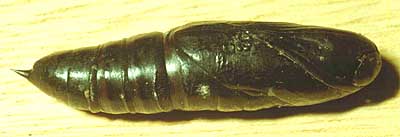 |
There are a number of parasites that attack titan. Cryptophion (Ichneumonidae), Belvosia, Drino piceiventris (Tachinidae) are a few.
The pronunciation of scientific names is troublesome for many. The "suggestion" at the top of the page is
merely a suggestion. It is based on commonly accepted English pronunciation of Greek names and/or some
fairly well accepted "rules" for latinized scientific names.
The suggested pronunciations, on this page and on other pages, are primarily put forward to assist those who hear with internal ears as they read.
There are many collectors from different countries whose
intonations and accents would be different.
Some of the early describers/namers chose genus and species names indicating some character of the insect, but more
often, they simply chose names from Greek or Roman mythology or history. Those species names which end in "ensis" indicate a
specimen locale, and those which end in "i", pronounced "eye", honour a contempory friend/collector/etc.
In Greek Mythology, Aello, also known as Aellopos, is one of the harpies. Her name means 'The Stormy One'.
The species name "titan" is probably for one of Saturn's many moons, or it could be for Titan, one of the giant children of Uranus.
Return to U. S. A. Table
Return to Sphingidae Index
Return to Dilophonotini Tribe
Use your browser "Back" button to return to the previous page.
This page is brought to you by Bill Oehlke and the WLSS. Pages are on space rented from Bizland. If you would like to become a "Patron of the Sphingidae Site", contact Bill.
Please send sightings/images to Bill. I will do my best to respond to requests for identification help.
Very nice to see something green while snow covers the ground here in Prince Edward Island, Canada:
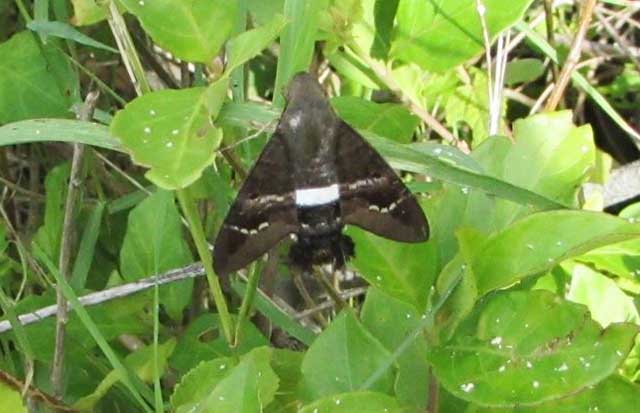
Aellopos titan, Saint Peter, Rio de Janeiro, Brazil,
March 22, 2020, courtesy of Biologia Beth Franco, id by Bill Oehlke.